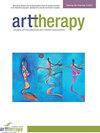BIPOC Art Therapists: Antiracism Work Through the Virtual Circle
IF 1.3
Q3 PSYCHOLOGY, CLINICAL
引用次数: 2
Abstract
Abstract In the wake of 2020’s racial tension and civil unrest in the United States, Black, Indigenous, and People of Color (BIPOC) art therapists and graduate students found themselves in need of support from like-minded, social justice-oriented peers. A virtual monthly peer support group called the BIPOC Art Therapists’ Circle was formed. A different member selected reading materials to which members created response art. Outcomes of the Circle include: shared experience of oppression; connection and empowerment through art sharing; safety; emotional support and validation; vulnerability and authenticity; widened perspectives; and motivation to advocate outside of circle meetings. The experience of the BIPOC circle confirms its critical importance as a source of support for BIPOC art therapists and students.BIPOC艺术治疗师:通过虚拟圈子的反种族主义工作
摘要在2020年美国种族紧张和内乱之后,黑人、原住民和有色人种(BIPOC)艺术治疗师和研究生发现自己需要志同道合、以社会正义为导向的同龄人的支持。成立了一个名为BIPOC艺术治疗师圈的虚拟月度同伴支持小组。一位不同的成员选择了阅读材料,成员们根据这些材料创作了反应艺术。该圈子的成果包括:共同的压迫经历;通过艺术分享实现联系和赋权;安全情感支持和验证;脆弱性和真实性;拓宽视野;以及倡导圈外会议的动机。BIPOC圈子的经验证实了它作为BIPOC艺术治疗师和学生支持来源的关键重要性。
本文章由计算机程序翻译,如有差异,请以英文原文为准。
求助全文
约1分钟内获得全文
求助全文

 求助内容:
求助内容: 应助结果提醒方式:
应助结果提醒方式:


